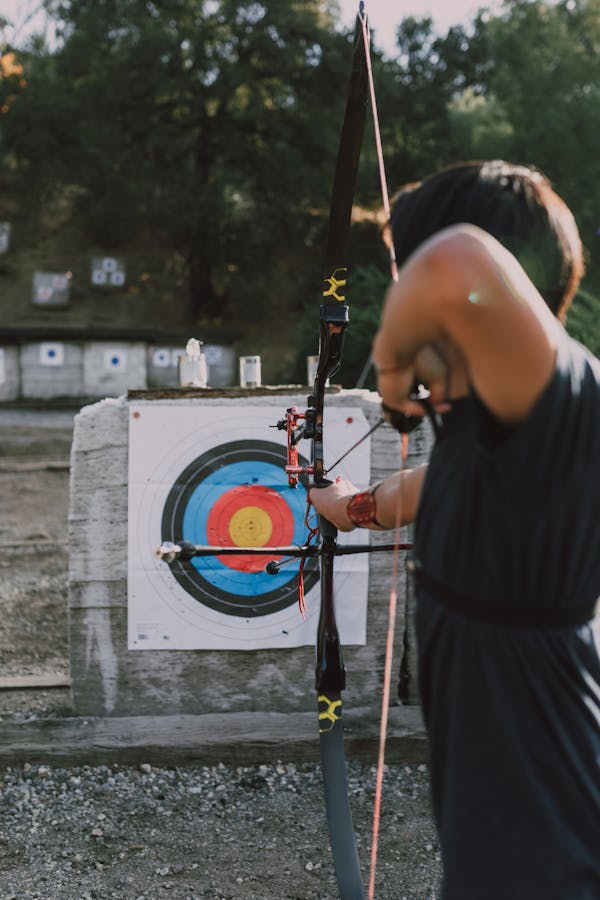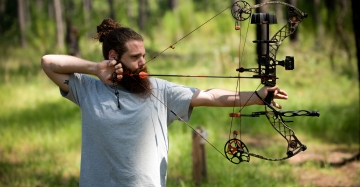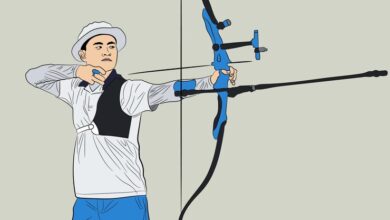The Best Material To Make An Archery Target

The Best Material To Make An Archery Target, Archery requires precision and skill, so a quality target is crucial to improve accuracy. There are different factors to consider when choosing the best material for an archery target, such as durability, cost, and ease of use. We will explore these factors and discuss the most common materials used for archery targets in this post. Understanding the appropriate material for an archery target is vital for success in this sport, whether you are a beginner or a seasoned archer.
Here Are 5 Best Materials For Archery Targets:
Hay Bales Target:
Hay bales are an excellent option for archery targets due to their exceptional stopping power and durability. The natural density of hay creates a consistent surface to shoot at, allowing archers to have a clear understanding of their accuracy and precision.
Moreover, hay bales are readily available and cost-effective, making them an accessible option for archers of all levels. The layered construction of hay bales also provides an added layer of safety by preventing arrows from passing through, reducing the risk of accidents.
Additionally, hay bales are easy to assemble and modify, allowing archers to create targets of their desired size and shape. Whether you practice in your backyard or at an archery range, hay bales are an excellent choice as they offer a sturdy, affordable, and enjoyable practice experience.
Solid Foam Block Targets:
Solid foam block targets are considered the best option for archery practice for several reasons. These targets are extremely durable and can withstand numerous arrow strikes without breaking. The foam material absorbs the energy from each shot, preventing arrows from penetrating too deeply and making arrow removal easier.
Additionally, solid foam block targets have a large surface area that provides a visible target for archers, improving accuracy and precision. These targets are versatile and can be used both indoors and outdoors since they are lightweight and portable.
Archers can adjust the length and angle of their practice sessions to suit their training needs and skill levels. Overall, solid foam block targets provide archers with a durable and precise option that promotes efficient training, helping them to improve their performance in the sport of archery.
3-D Targets:
Archers can practice their skills on targets that closely resemble various game animals, providing a realistic and engaging experience.
3-D targets replicate the anatomy of animals like deer, elk, squirrels or rabbits with lifelike details and contours.
These targets are typically made from high-density foam, which allows easy arrow removal while maintaining durability.
The foam material ensures that arrows penetrate the target without causing excessive damage.
Additionally, 3-D targets provide a more authentic simulation of hunting situations, incorporating the challenge of shooting at varying angles and distances.
They help archers refine their accuracy, judgment, and shot placement, while also offering a dynamic shooting experience.
With their realistic design, effective arrow stopping capabilities, and ability to simulate hunting scenarios, 3-D targets are an excellent choice for archery enthusiasts seeking a versatile and engaging practice tool.
Bag Targets:
These targets are made from a durable fabric material filled with a combination of synthetic fibers or foam blocks.
The design of bag targets allows them to effectively absorb the impact of arrows, providing a satisfying sensation and reducing noise.
Additionally, bag targets offer a high level of versatility, as they can withstand various types of bows and arrow tips, whether they are field points or broadheads.
The human-like silhouette printed on most bag targets also helps archers to practice their aim and accuracy, simulating real-life hunting scenarios.
Furthermore, bag targets are portable and lightweight, making them easily transportable to different shooting locations. They can be hung from hooks or placed on the ground, further illustrating their adaptability.
Ultimately, bag targets offer archers an optimal combination of durability, versatility, and realism, making them the best choice for archery practice and training.
Rag bag:
A rag bag is a collection of old and discarded fabric scraps that are tightly packed together. It serves as an ideal target for archery practice as it offers several benefits.
Firstly, the multiple layers of fabric provide excellent stopping power. This effectively stops arrows upon impact and prevents them from penetrating through.
Moreover, the varied composition of the fabric scraps creates a surface with diverse densities and materials. This mimics real-life shooting conditions, making it an excellent practice target for archers.
This helps archers to refine their aim and accuracy. Also, the rag bag target is cost-effective since it utilizes repurposed fabric materials, making it an eco-friendly choice.
Furthermore, the construction of the rag bag allows for easy arrow removal and replacement, extending the target’s lifespan.
Overall, the rag bag target proves to be practical and sustainable, making it an excellent option for archery enthusiasts seeking a durable and effective target for their practice sessions.
Which materials are the most durable for archery targets?
When choosing materials for archery targets, it is crucial to consider several factors, including durability. The materials used should be able to withstand hits from arrows without breaking easily. Historically, straw bales have been a popular choice because they absorb the energy from arrows well and are easy to maintain. Properly maintained straw targets can handle extensive use and make removing arrows simple.
In recent years, foam targets, particularly those made from closed-cell foam, have become increasingly popular. These targets have good stopping power and are relatively resistant to wear and tear.
To lessen unequal compression, they do need to be rotated on a regular basis. Some archers choose layered foam targets because they use many foam sheets to improve durability and extend their life.
Finally, self-healing foam or rubber-like materials are frequently used to create three-dimensional targets for hunting and field archery practice.
These targets are a sturdy choice for genuine training exercises because they match actual animals in shape and appearance and can resist repeated arrow piercings.
The selection of materials ultimately comes down to the archer’s particular needs and personal taste.
FAQS:
What is the best material to use when making an archery target?
A durable archery target should stop arrows repeatedly without damage. Popular materials include high-density foam, compressed straw, and layered synthetic textiles.
What are the advantages of using high-density foam for an archery target?
Targets made of high-density foam are renowned for their remarkable durability and stopping capability.
They are capable of handling arrows from several bow styles, including quick compound bows foam targets are also portable and weatherproof, making them appropriate for usage both inside and outside.
Is compressed straw a good option for an archery target?
Compressed straw targets, also known as bales, have been a popular choice for archery practice for many years. They are affordable, easily obtainable, and offer decent stopping power for arrows. However, they have a tendency to wear out relatively quickly, especially when used with high-velocity arrows, and may require frequent replacement.
What about layered synthetic fabrics?
Layered synthetic fabric targets, such as those created from woven synthetic fibers or ballistic nylon, are becoming more and more common.
These targets are made up of several layers that cooperate to successfully deflect arrows. Both novice and seasoned archers can use them since they offer a fair mix of stopping force and durability.
How should I choose the best material for my archery target?
When choosing a target material, consider your shooting technique, bow type, and intended use (indoor/outdoor). Also, think about price, quality, and ease of arrow removal. Seek recommendations and read reviews to make an informed decision. Prioritize safety when firing arrows. Ensure that your target is positioned correctly, set up safely, and has an appropriate backstop


